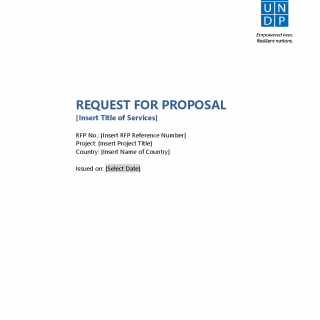Request for Proposal (RFP)
A request for proposal is an invitation for suppliers, often through a bidding process, to submit a proposal on a specific commodity or service. A bidding process is one of the best methods for leveraging a company's negotiating ability and purchasing power with suppliers. The request for proposal process brings structure to the procurement decision and allows the risks and benefits to be identified clearly upfront. The request for proposal purchase process is lengthier than others, so it is used only where its many advantages outweigh any disadvantages and delays caused. The added benefit of input from a broad spectrum of functional experts ensures that the solution chosen will suit the company's requirements.
Commonly referred to as an RFP, the request for proposal is a document utilized by many organizations to receive offers of services or goods from potential vendors. The exact structure for an RFP will vary from one situation to another. This means that the formula for how to write a request for proposal will depend a great deal on the culture of the entity that is issuing the request and what they hope to learn from the responses. Here are some examples of elements that are found in many requests for proposal regardless of the industry or organization involved.
The request for proposal may dictate to varying degrees the exact structure and format of the supplier's response. The creativity and innovation that suppliers choose to build into their proposals may be used to judge supplier proposals against each other, at the risk of failing to capture consistent information between bidders and thus hampering the decision making process. Effective RFPs typically reflect the strategy and short/long-term business objectives, providing detailed insight upon which suppliers will be able to offer a matching perspective.
As with many business writing efforts, a proper request for proposal will begin by stating the purpose for the document. This can usually be summed up in a few sentences and allows the applicants or parties invited to submit a formal proposal to know exactly what the issuing entity is looking for in the way of services or goods. Even the most casual of formats for an RFP will include information of this nature.
Along with stating the purpose or reason for the RFP, it is not unusual for some general information about the entity to be included. The information usually provides limited details on the size of the company, the number of locations currently maintained and any immediate plans for expansion that could impact the responses of the applicants. Usually, the detail is not meant to be comprehensive. However, it is usually enough to allow applicants to conduct research on their own to expand their understanding of the needs of the party issuing the proposal request.
In structure, a request for proposal can be very broad or highly detailed. Some requests are no longer than one page and include only general guidelines for submission, such as a few specific areas to address, how to submit the finished proposal, and the date that all proposals are due. Other RFPs provide specific sections and a format that must be followed without fail.
There are advantages to both of these approaches to formatting the request for proposal. The broad format ensures that necessary information will be contained in the body of the response, but allows the entity to get an idea of how each applicant presents themselves when allowed a great deal of leeway in the response. In contrast, a highly structured format tells the applicant exactly how to organize data in a way that is sure to have meaning for the issuing entity. At the same time, the comprehensive structure makes it possible to literally compare the responses from several respondents side by side, going down the list of sections one by one.
Depending on the type of service or goods involved, the request for proposal may contain example scenarios that illustrate what the originator of the request needs from a vendor in both routine and emergency situations. For example, if the RFP is for teleconferencing services, the originator may wish to know if the vendor can guarantee the availability of a particular number of ports or lines even during peak business periods. The vendor may also address specific issues such as the implementation of a support network for use in the case of a company wide emergency, or if the vendor can handle scheduling and executing conference calls without little to no prior notice.
Businesses or other organizations that need to issue an RFP but are not sure how to structure the document to best advantage can often begin the process by using one of the many free request for proposal template options found online. These templates can be modified as needed. In some cases, the templates will come with at least one request for proposal example, which will serve as a guide for the individual or team charged with the responsibility of preparing the RFP.
An RFP typically involves more than a request for the price. Other requested information may include basic corporate information and history, financial information (can the company deliver without risk of bankruptcy), technical capability (used on major procurements of services, where the item has not previously been made or where the requirement could be met by varying technical means), product information such as stock availability and estimated completion period, and customer references that can be checked to determine a company's suitability.

